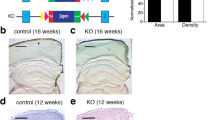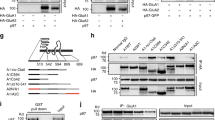Abstract
The mechanisms responsible for enhanced transmission during long-term potentiation (LTP) at CA1 hippocampal synapses remain elusive. Several popular models for LTP expression propose an increase in 'use' of existing synaptic elements, such as increased probability of transmitter release or increased opening of postsynaptic receptors. To test these models directly, we studied a GluR2 knockout mouse in which AMPA receptor transmission is rendered sensitive to a use-dependent block by polyamine compounds. This method can detect increases during manipulations affecting transmitter release or AMPA receptor channel open time and probability, but shows no such changes during LTP. Our results indicate that the recruitment of new AMPA receptors and/or an increase in the conductance of these receptors is responsible for the expression of CA1 LTP.
This is a preview of subscription content, access via your institution
Access options
Subscribe to this journal
Receive 12 print issues and online access
$209.00 per year
only $17.42 per issue
Buy this article
- Purchase on Springer Link
- Instant access to full article PDF
Prices may be subject to local taxes which are calculated during checkout








Similar content being viewed by others
References
Bliss, T. V. & Collingridge, G. L. A synaptic model of memory: long-term potentiation in the hippocampus. Nature 361 , 31–39 (1993).
Malinow, R. & Tsien, R. W. Presynaptic enhancement shown by whole-cell recordings of long-term potentiation in hippocampal slices. Nature 346, 177–180 ( 1990).
Kullmann, D. M. & Nicoll, R. A. Long-term potentiation is associated with increases in quantal content and quantal amplitude. Nature 357, 240–244 ( 1992).
Larkman, A., Hannay, T., Stratford, K. & Jack, J. Presynaptic release probability influences the locus of long-term potentiation. Nature 360, 70–73 ( 1992).
Liao, D., Jones, A. & Malinow, R. Direct measurement of quantal changes underlying long-term potentiation in CA1 hippocampus. Neuron 9, 1089–1097 (1992).
Stevens, C. F. & Wang, Y. Changes in reliability of synaptic function as a mechanism for plasticity. Nature 371, 704–707 (1994).
Bolshakov, V. Y. & Siegelbaum, S. A. Regulation of hippocampal transmitter release during development and long-term potentiation. Science 269, 1730 –1734 (1995).
Foster, T. C. & McNaughton, B. L. Long-term enhancement of CA1 synaptic transmission is due to increased quantal size, not quantal content. Hippocampus 1, 79–91 (1991).
Manabe, T., Renner, P. & Nicoll, R. A. Postsynaptic contribution to long-term potentiation revealed by the analysis of miniature synaptic currents. Nature 355, 50–55 ( 1992).
Liao, D., Hessler, N. A. & Malinow, R. Activation of postsynaptically silent synapses during pairing-induced LTP in CA1 region of hippocampal slice. Nature 375, 400–404 ( 1995).
Isaac, J. T., Nicoll, R. A. & Malenka, R. C. Evidence for silent synapses: implications for the expression of LTP. Neuron 15, 427– 434 (1995).
Isaac, J. T., Hjelmstad, G. O., Nicoll, R. A. & Malenka, R. C. Long-term potentiation at single fiber inputs to hippocampal CA1 pyramidal cells. Proc. Natl. Acad. Sci. USA 93, 8710 –8715 (1996).
Stricker, C., Field, A. C. & Redman, S. J. Changes in quantal parameters of EPSCs in rat CA1 neurones in vitro after the induction of long-term potentiation. J. Physiol. (Lond.) 490, 443–454 (1996).
Kullmann, D. M. Amplitude fluctuations of dual-component EPSCs in hippocampal pyramidal cells: implications for long-term potentiation. Neuron 12, 1111–1120 (1994).
Durand, G. M., Kovalchuk, Y. & Konnerth, A. Long-term potentiation and functional synapse induction in developing hippocampus. Nature 381, 71 –75 (1996).
Kullmann, D. M., Erdemli, G. & Asztely, F. LTP of AMPA and NMDA receptor-mediated signals: evidence for presynaptic expression and extrasynaptic glutamate spill-over. Neuron 17, 461–474 ( 1996).
Asztely, F., Erdemli, G. & Kullmann, D. M. Extrasynaptic glutamate spillover in the hippocampus: dependence on temperature and the role of active glutamate uptake. Neuron 18, 281–293 ( 1997).
Lynch, G. & Baudry, M. The biochemistry of memory: a new and specific hypothesis. Science 224, 1057 –1063 (1984).
Maren, S., Tocco, G., Standley, S., Baudry, M. & Thompson, R. F. Postsynaptic factors in the expression of long-term potentiation (LTP): increased glutamate receptor binding following LTP induction in vivo. Proc. Natl. Acad. Sci. USA 90, 9654–9658 (1993).
Ambros-Ingerson, J. & Lynch, G. Channel gating kinetics and synaptic efficacy: a hypothesis for expression of long-term potentiation. Proc. Natl. Acad. Sci. USA 90, 7903– 7907 (1993).
Roche, K. W., Tingley, W. G. & Huganir, R. L. Glutamate receptor phosphorylation and synaptic plasticity. Curr. Opin. Neurobiol. 4, 383– 388 (1994).
Benke, T. A., Anderson, W. W. & Collingridge, G. L. AMPA receptor channel conductance is increased in LTP CA1 region of rat hippocampus. Nature 393, 793–797 (1998).
Hessler, N. A., Shirke, A. M. & Malinow, R. The probability of transmitter release at a mammalian central synapse. Nature 366, 569– 572 (1993).
Rosenmund, C., Clements, J. D. & Westbrook, G. L. Nonuniform probability of glutamate release at a hippocampal synapse. Science 262, 754– 757 (1993).
Manabe, T. & Nicoll, R. A. Long-term potentiation: evidence against an increase in transmitter release probability in the CA1 region of the hippocampus. Science 265, 1888– 1892 (1994).
Washburn, M. S. & Dingledine R. Block of alpha-amino-3-hydroxy-5-methyl-4-isoxazolepropionic acid (AMPA) receptors by polyamines and polyamine toxins . J. Pharmacol. Exp. Ther. 278, 669–678 (1996).
Bahring R. & Mayer, M. L. An analysis of philanthrotoxin block for recombinant rat GluR6(Q) glutamate receptor channels. J. Physiol. (Lond.) (in press).
Washburn, M. S., Numberger, M. Zhang, S. & Dingledine, R. Differential dependence on GluR2 expression of three characteristic features of AMPA receptors. J. Neurosci. 17, 9393– 9406 (1998).
Jia, Z. et al. Enhanced LTP in mice deficient in the AMPA receptor GluR2. Neuron 17, 945–956 ( 1996).
Malgaroli, A. et al. Presynaptic component of long-term potentiation visualized at individual hippocampal synapses. Science 268, 1624–1628 (1995).
Huang, E. P. & Stevens, C. F. Estimating the distribution of synaptic reliabilities. J. Neurophysiol. 78, 2870–2880 (1997).
Dobrunz, L. E. & Stevens, C. F. Heterogeneity of release probability, facilitation, and depletion at central synapses. Neuron 18, 995–1008 ( 1997).
Isaacson, J. S. & Nicoll, R. A. Aniracetam reduces glutamate receptor desensitization and slows the decay of fast excitatory synaptic currents in the hippocampus. Proc. Natl. Acad. Sci. USA 88, 10936–10940 ( 1991).
Tang, C. M., Shi, Q. Y., Katchman, A. & Lynch, G. Modulation of the time course of fast EPSCs and glutamate channel kinetics by aniracetam. Science 254, 288–290 ( 1991).
Partin, K. M., Fleck, M. W. & Mayer, M. L. AMPA receptor flip/flop mutants affecting deactivation, desensitization, and modulation by cyclothiazide, aniracetam, and thiocyanate. J. Neurosci. 16, 6634– 6647 (1996).
Traynelis, S. F. & Wahl, P. Control of rat GluR6 glutamate receptor open probability by protein kinase A and calcineurin. J. Physiol. (Lond.) 503, 513–531 (1997).
Greengard, P., Jen, J., Nairn, A. C. & Stevens, C. F. Enhancement of the glutamate response by cAMP-dependent protein kinase in hippocampal neurons. Science 253, 1135– 1138 (1991).
Wu, G., Malinow, R. & Cline, H. T. Maturation of a central glutamatergic synapse. Science 274, 972–976 ( 1996).
Spacek, J. & Harris, K. M. Three-dimensional organization of smooth endoplasmic reticulum in hippocampal CA1 dendrites and dendritic spines of the immature and mature rat. J. Neurosci. 17, 190–203 (1997).
Lledo, P. M., Zhang, X., Sudhof, T. C., Malenka, R. C. & Nicoll, R. A. Postsynaptic membrane fusion and long-term potentiation. Science 279, 399–403 (1998).
Constantine-Paton, M. & Cline, H. T. LTP and activity-dependent synaptogenesis: the more alike they are, the more different they become. Curr. Opin. Neurobiol. 8, 139–148 (1998).
Lisman, J., Malenka, R. C., Nicoll, R. A. & Malinow, R. Learning mechanisms: the case for CaM-KII. Science 276, 2001–2002 (1997).
Maletic-Savatic, M., Koothan, T. & Malinow, R. Calcium-evoked dendritic exocytosis in cultured hippocampal neurons. Part II: mediation by calcium/calmodulin-dependent protein kinase II. J. Neurosci. 18, 6814– 6821 (1998).
Shirke, A. M. & Malinow, R. Mechanisms of potentiation by calcium-calmodulin kinase II of postsynaptic sensitivity in rat hippocampal CA1 neurons. J. Neurophysiol. 78, 2682–2692 (1997).
Nishimune, A. et al. NSF binding to GluR2 regulates synaptic transmission. Neuron 21, 87–97 ( 1998).
Nayak, A., Zastrow, D. J., Licksteig, R., Zahniser, N. R. & Browning, M. D. Maintenance of late-phase LTP is accompanied by PKA-dependent increase in AMPA receptor synthesis. Nature 394, 680–683 ( 1998).
Wan, Q. et al. Recruitment of functional GABA(A) receptors to postsynaptic domains by insulin. Nature 388, 686– 690 (1997).
Acknowledgements
We thank H. Cline, K. Svoboda and members of the Malinow lab for comments on the manuscript and Y. Hayashi and N. Dawkins for assistance in genotyping. Supported by N.I.H. and Mathers Foundation (R.M.) and a Burroughs Wellcome Fund Career Award (Z. F. M.).
Author information
Authors and Affiliations
Corresponding author
Rights and permissions
About this article
Cite this article
Mainen, Z., Jia, Z., Roder, J. et al. Use-dependent AMPA receptor block in mice lacking GluR2 suggests postsynaptic site for LTP expression. Nat Neurosci 1, 579–586 (1998). https://doi.org/10.1038/2812
Accepted:
Issue Date:
DOI: https://doi.org/10.1038/2812
This article is cited by
-
Regulatory mechanisms of AMPA receptors in synaptic plasticity
Nature Reviews Neuroscience (2007)
-
Activity-dependent regulation of dendritic synthesis and trafficking of AMPA receptors
Nature Neuroscience (2004)
-
Rapid redistribution of glutamate receptors contributes to long-term depression in hippocampal cultures
Nature Neuroscience (1999)
-
Synaptic calcium transients in single spines indicate that NMDA receptors are not saturated
Nature (1999)



